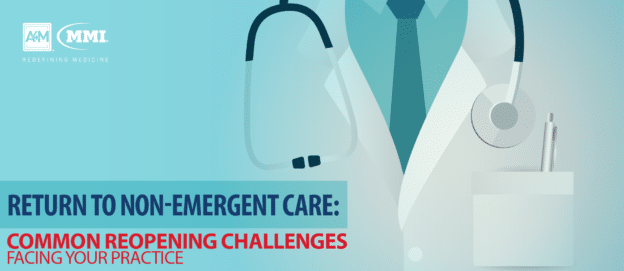Dr. Sachin Dave, an internist of the Indiana Internal Medicine Consultants stresses the importance of educating patients and communicating the risks to them. “My older patients actually insist on coming to see me in person,” he told Medscape in an interview, “I have to tell them it’s not safe.” Minimizing risk is paramount in the process of reopening medical practices across the United States and the globe; physicians must weigh the risks of increasing patient volume with patient and staff safety.
To assist healthcare practitioners in safely transitioning back to in-person care, Medscape has outlined some common challenges they may face in the reopening process, and how best to mitigate them.
1. Unclear or Nonexistent Policies and Protocols
While physicians and other staff members may be aware of the COVID-19 prevention rules implemented to help mitigate virus transmission, patients need to be made aware of them preferably in a readily available document; it is important to develop formal protocols for all to follow to minimize confusion and ensure safety.
This includes enforcing mandatory mask wear for both staff and patients, setting up facilities in accordance with social distancing guidelines, having alternate waiting areas or asking patients to wait in their cars if the space gets too crowded, and other protective strategies.
Ensure all patients understand and agree to adhere to your new policies before they come in; in addition, they should be triaged over the phone per CDC guidelines before attending an in-office visit. Without a formal framework, refusing care or assessment of patients who do not comply with guidelines may lead to patient abandonment claims, making clear policies paramount at this time.
2. Too Many Patients, Too Soon
According to data from the Medical Group Management Association (MGMA), practices report an average 55% decrease in revenue and 60% decrease in patient volume since the COVID-19 crisis began. As a result, experts believe practices may be tempted to ramp up capacity immediately to restore prior patient volume. However, this period requires slow and carefully implemented safety protocols.
Physicians and their patients are encouraged to take advantage of telehealth services while they remain reimbursable at parity. The elevated demand for online care is forecasted to continue growing as more patients become comfortable with the technology and services become more advanced. While some doctors want to see an overload of patients immediately upon reopening, there has to be a limit on the number of patients coming into an office as welcoming too many patients too fast can have dire consequences.
3. Lack of Communication
Another potential pitfall is under-communication; patients may not be aware that your practice has reopened or plans to do so. It is important to consistently update your practice’s website, send out letters or newsletters to patients, maintain phone and email contact, post signs explaining reopening protocols, and keep everyone in the loop. The CDC has provided phone advice line tools that practices can adapt to their needs to keep patients informed.
Instead of under-communicating, physicians are encouraged to over-communicate to their patients as well as their staff, making sure they are made aware of the extra precautions being taken to prioritize their health and safety. Practice staff should also be aware of policy changes to minimize confusion.
Experts believe that practices can emerge stronger from the pandemic if they promote strong patient education and build up goodwill at this time. Leverage the patient portal, using it as a trusted resource to inform patients about COVID-19 and preventative measures being taken at your practice.
4. Inadequate Staff Training
Some staff members may be apprehensive about returning to work as a result of virus-related fears. Clear guidance is needed to ensure safety, manage expectations, and offer flexibility with scheduling to address potential challenges before they occur.
Properly training staff members is essential to their safety and that of your patients; specific guidelines for staff – such as designating eating areas, staggering appointments – should be clearly articulated and readily available. Many staff members may not be used to donning and removing personal protective equipment or wearing masks when working with patients. Training staff members will help reassure patients that safety protocols are being adhered to.
5. Neglecting Documentation
With the changing standard of care, a consistent workflow is paramount. This includes proper documentation, communication with staff and patients, and the use of established systems aimed at mitigating COVID-19 risk. Experts recommend keeping an administrative file used to track new protocols, policies, and any incidents or breaches for future use.
6. Forgetting About Personal Mental and Physical Health
Physicians should be cognizant of the high potential of burnout and mental health state of their staff, their colleagues, and themselves. Mental exhaustion as a result of the persisting COVID-19 crisis and ongoing societal tensions is affecting all members of the population and has the potential to carry over to medical practices. To protect their mental and physical health as well as that of their staff members, physicians are encouraged to prioritize maintaining a positive culture at their practice – one in which everyone feels safe, taken care of and helps each other.
Practices and healthcare professionals located in areas which have deemed non-emergent care facilities eligible to reopen safely should take into consideration the aforementioned challenges and common pitfalls that may impede a smooth return to routine care. For those in search of comprehensive reopening recommendations and guidelines, The Doctors Company has developed an extensive checklist outlining the necessary steps for transitioning to in-person care – accessible here.




